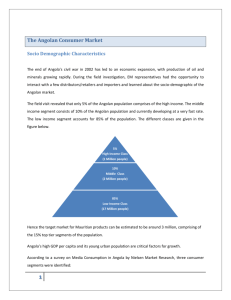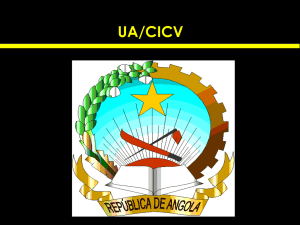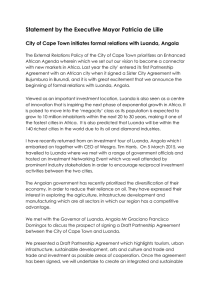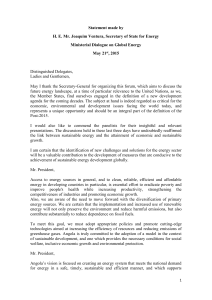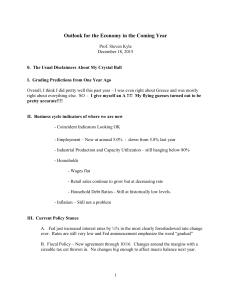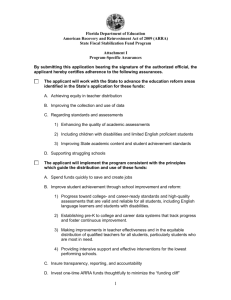Working Paper
advertisement
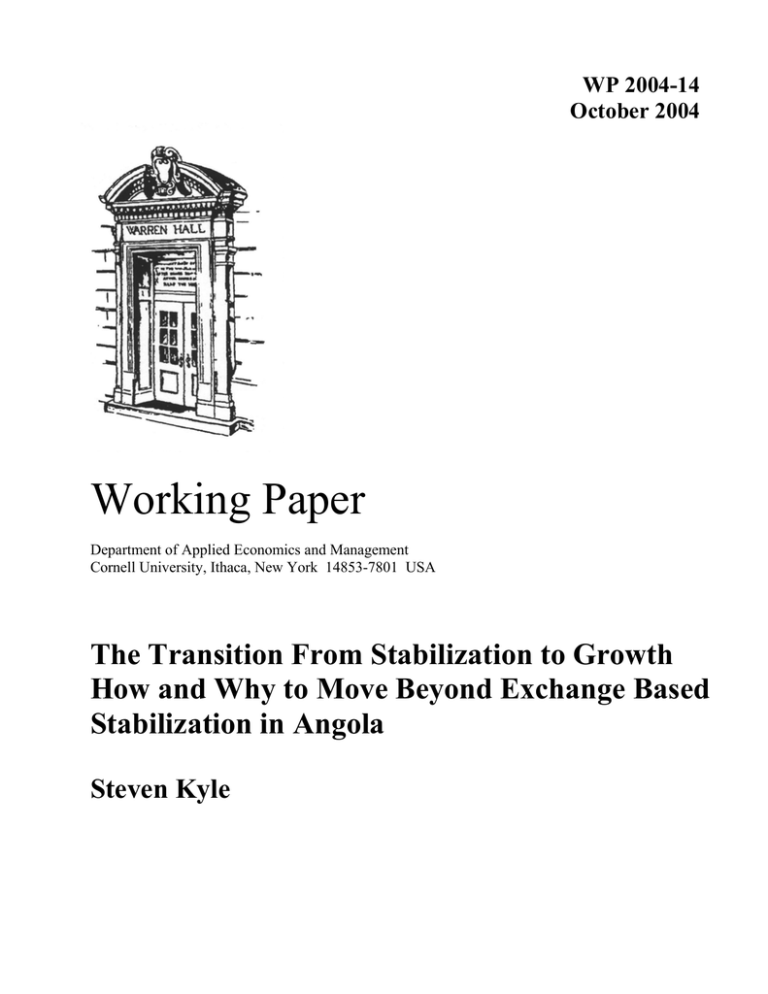
WP 2004-14 October 2004 Working Paper Department of Applied Economics and Management Cornell University, Ithaca, New York 14853-7801 USA The Transition From Stabilization to Growth How and Why to Move Beyond Exchange Based Stabilization in Angola Steven Kyle ABSTRACT The Transition From Stabilization to Growth How and Why to Move Beyond Exchange Based Stabilization in Angola Steven Kyle October 2004 This article argues the pros and cons of the Angolan government’s current policy of exchange rate based stabilization. First, the current policy is described together with a rationale in favor of such a program. Second, the reasons for being opposed to such a strategy are discussed. Third, is a discussion of how to move from the current policy regime to one more supportive of long term growth. In brief, the paper argues that the short run benefits of stabilizing the economy and restoring confidence in the currency were worthwhile, but that as time goes on the increasing costs of maintaining the policy begin to outweigh the benefits. In particular, the high dollar cost of stabilizing inflation and the Kwanza impose costs on import-exposed producers and directly on the government itself which will impede future growth. The Transition From Stabilization to Growth How and Why to Move Beyond Exchange Based Stabilization in Angola I. Introduction This article argues the pros and cons of the Angolan government’s current policy of exchange rate based stabilization. First, the current policy is described together with a rationale in favor of such a program. Second, the reasons for being opposed to such a strategy are discussed. Third, is a discussion of how to move from the current policy regime to one more supportive of long term growth. In brief, the paper argues that the short run benefits of stabilizing the economy and restoring confidence in the currency were worthwhile, but that as time goes on the increasing costs of maintaining the policy begin to outweigh the benefits. In particular, the high dollar cost of stabilizing inflation and the Kwanza impose costs on import-exposed producers and directly on the government itself which will impede future growth. II. Exchange Rate Based Stabilization - What it Is, Why the Government is Doing It, and Why the IMF Doesn’t Like It The View From Luanda Two years ago, the Angolan economy remained on path of stop-go cycles of inflation and devaluation coupled with extremely low confidence in the domestic currency. The root causes of these cycles can in theory vary from time to time and country to country but in the Angolan case most serious observers agree that the ongoing money financed deficits of the government played a central role in the inflationary process. While some would maintain that there is only one possible way to deal with this situation - i.e. fiscal contraction, it is clear that while fiscal balance must be a part of any path to long run stability, in fact there is a range of choices, each with its own advantages and drawbacks. By far the most commonly applied, not least because it is favored by the IMF, is a fiscal contraction combined with a devaluation of the currency in order to deal with exchange imbalances and problems in the balance of trade. It is clear that such a strategy, as a matter both of arithmetic and the record of experience of countries that have pursued it, can succeed in ending both the inflationary process and imbalances in the international accounts. However, the experience of these countries also demonstrates that there is a serious cost to such a strategy - Namely, the depth of the fiscal contraction required to achieve balance can be very large, with a correspondingly sharp recession or even depression as a result. This recessionary impact is likely to be more pronounced the less responsive the demand for imports to changes in their price. This is very probably the case in Angola, given the fact that Angolan 1 substitutes for imported food and manufactures could not be easily produced in the extremely difficult conditions of a country only newly emerged from a long and destructive civil war. The attraction of a path that could avoid such an immediate and sharp fiscal retrenchment is obvious. With domestic need for expenditure so large due both to poverty alleviation and rehabilitation, a fiscal retrenchment would inevitably mean a delay in addressing these issues. Many critics have observed that most government expenditure was not (and still isn’t) really devoted to rehabilitation or poverty alleviation, going instead to politically favored recipients. Even so, it can be argued that the very beginning of what for Angola is the third attempt at a peaceful beginning to development since independence is a particularly inopportune time to start a major campaign of stabilization based fundamentally on cutting government support across wide swathes of the politically powerful in the country. Accordingly, the government had a strong incentive to avoid a policy that would require an immediate fiscal contraction in favor of one which could achieve a measure of stability while postponing cuts in expenditure. A further argument in favor of such a path is the need of the government to achieve a visible success in economic management in order to build the political capital to take on the difficult task of reducing expenditure. The policy chosen was exchange rate based stabilization. Though the government does not view its policy package as an intentional application of this strategy, it is in fact indistinguishable from similar efforts taken in several other countries over the past two decades. What does this mean? In Angola, the policy has meant that expenditures by the government which threaten to spark inflation due to the emission of large amounts of Kwanzas into the economy are countered by having the exchange authorities in the Banco Nacional de Angola purchase these excessive Kwanzas with dollars deriving either from oil receipts or from loans backed by promises of future oil receipts. There are three beneficial consequences of this policy. First, with excess Kwanzas constantly removed from circulation, the inflationary pressure deriving from money expansion is greatly lessened, permitting the decline in the rate of inflation that we have in fact witnessed in Angola over the past year and a half. The second (and according to the government, secondary in importance) is a quasi-fixed exchange rate. It can be considered “quasi” fixed in that it is not fixed by decree as in a true fixed exchange rate system but rather is fixed in a de facto sense. As can be seen in the statistics on the exchange rate from the BNA, the nominal exchange rate has not deviated far from 80 Kwanzas to the dollar since the middle of 2003. Preventing devaluation of the exchange rate has anti-inflationary influences of its own hence the name “exchange rate based stabilization”. The near fixity of the exchange rate means that there is a corresponding constancy in the prices of imported goods, eliminating inflationary pressures from this source. The above discussion makes clear the reasons for the application of this strategy in Angola. The costs are discussed below 2 The View from the IMF First, it must be said that at the current time the IMF is moving toward an accord with the government, and therefore does not view the current use of exchange rate based stabilization as a bar to reaching an agreement. However, it is fair to say that the history of the IMF and client countries with such programs leads them to be skeptical of the Angolan program and to recommend an end to this policy in the context of an agreement. Why is this? The table below1 shows the experience of six countries with a policy regime similar to that currently being pursued by Angola. Half of the countries succeeded in stabilizing without renewed crisis, while half did not. The one factor that distinguishes the success cases from the failures is the extent to which governments pursued fiscal contraction in support of their stabilization effort. Those countries that did not reduce expenditures, Brazil, Mexico and Argentina, ended their stabilization efforts in a renewed inflation, rock bottom confidence in the domestic currency, and severe blows to investment and growth. Table 1 : Experience of Six Countries with Exchange Based Stabilization Country Start & End Dates Israel June 85 Sept 86 Feb 86 – Nov 86 Dec 87 – Dec 94 Brazil Mexico Peru Aug 90 – Dec 99 Dominican Republic Aug 90 – Dec 99 Argentina Apr 91 – Dec 01 Exchange Rate Arrangement Fixed, crawling peg Fixed Fixed, Crawling peg, band Monetary anchor/dirty float ER unification & floating Currency Board Initial Rate of Inflation 1128.9 Lowest Inflation Achieved 50.1 No 286.0 76.2 Yes 159.0 6.7 Yes 12,378 10.2 No 60.0 2.5 No 267.0 - 0.3 Yes 1 Ended in Crisis? Taken from Jose Gasha and Gonzalo Pastor “Angola’s Fragile Stabilization” IMF Working Paper WP/04/83 May 2004 3 Clearly, though all of the countries on the list achieved impressive reductions in inflation, this alone was not enough to guarantee success. Argentina even achieve negative inflation in 1996, but failure to achieve fiscal control meant an eventual return to a crisis situation and virtual collapse of the country’s financial system. It is also important to note that one of the success cases, Israel, only reduced inflation to 50%, though in this case the period of implementation of the policy was only a little more than a year. Clearly, the absolute level of inflation reduction achieved is not the key variable in determining the outcome. What is key, and what is the core of the problem in the Angolan case, is fiscal expenditure reduction and/or revenue increase. Fiscal balance, or near balance is fundamental to any successful outcome to Angola’s experience with exchange rate based stabilization. Though the delay in achieving this initially need not mean the failure of the program or a necessary return to inflationary cycles, all observers agree that this adjustment must occur at some point if Angola is to be counted among the successes on the above table and not the failures. III. Why to End the Policy Regime If the current policy regime could continue indefinitely, there would be no reason to seek an alternative but historical experience in other countries and the situation in Angola today demonstrate that whether through action or inaction, something will change. The lack of a fiscal adjustment is one very powerful reason to expect that this, at a minimum, must be corrected before the policy regime can be ended. But why end it? Angola can certainly go on for a long time due to its very large oil receipts. These would allow funding of continued purchase of kwanzas for a long time to come, and certainly longer than non-mineral countries could hope to do. However, there are three powerful reasons to reject this option. These are: 1. The current policy is extremely expensive. The Angolan government’s figures indicate that these expenditures have reached $250 million per month. This is a colossal amount of money, and one which, if continued at its current rate, would imply an expenditure of $3 billion this year to hold the exchange rate at its current level. This amounts to more than $200 for every man woman and child in the country, an amount that could go far toward addressing poverty problems, not to mention the needs for investment in roads, bridges and other infrastructure destroyed in the war. Worse, there is no reason to expect the amount needed to stabilize the exchange rate to remain at “only” $250 million per month. Since the beginning of the policy there has been an unmistakable upward trend in the amount necessary to keep the exchange rate at its current level - and there is every reason to expect this to continue as the divergence between the quasi-fixed rate and the “natural” rate that we would see if there were no intervention grows. This divergence is a result of the fact that inflation has continued (though at a decreasing rate) and is expected to amount to somewhere in the neighborhood of 35-40% in 2004. 4 This means that sooner or later the government will not have enough money to stabilize the exchange rate. As this becomes apparent, the public will increasingly flee from the Kwanza, in order to avoid the costs of holding large sums in domestic currency that is in danger of a large devaluation. This will itself hasten the onset of such a devaluation. 2. The appreciation of the “real” exchange rate over the past two years has made imports ever more competitive and exports ever less competitive as the inflation-driven rise of domestic costs has squeezed would-be producers who cannot raise their own sale prices because of the fixity of the exchange rate. Constant international prices in dollar terms coupled with a fixed exchange rate means that prices of exports and imports don’t rise proportionately with other prices in the economy. The figure below shows that the real exchange rate has appreciated to the point where the index has reached a value of 51 since January of 2001. In other words, Angolan producers earn Figure 1: Angolan Real Exchange Rate Index vs. US Dollar January 2001 = 100 5 J un-04 Feb-04 O c t-03 J un-03 Feb-03 O c t-02 J un-02 Feb-02 O c t-01 J un-01 Feb-01 O c t-00 J un-00 Feb-00 O c t-99 J un-99 160 140 120 100 80 60 40 20 0 only half what they did two years ago in real terms. Conversely, the real cost of imports is half what it was two years ago. It is important to note that even though inflation has dropped, if it continues at all in the face of a constant exchange rate then the real exchange rate will continue to appreciate. Why is this a problem? Rising costs and a sale price that doesn’t rise proportionately mean that profits are squeezed. If this continues, there is a point at which domestic producers can be driven completely out of business (or can never get a business started) if imports can be brought into the country more cheaply than goods can be produced at home. This is obviously the case for many items in Luanda, Benguela, and other ports, but the difficulty and expense of transportation to the interior lends a degree of “protection” to producers located, for example, on the planalto. However, there is a real danger of even this “protection” being overcome if the real exchange rate appreciates enough. A real example can illustrate this: Consider the cost of a ton of maize. This is a commodity which is fundamental to the economy of the country and even to the basic culture of large portions of the population. Rehabilitation of maize production is fundamental to rehabilitation of the agricultural economy of the country and to the welfare of millions. Figure 2 shows the prices measured for a ton of maize in different points in the country in April 2004 in local markets upon delivery by informal truckers from farm areas. The figures for Luanda and Benguela are from markets on the outskirts of the cities while those for other provinces are averages of prices in outlying municipalities. How does this compare with the price of imported maize? These prices averaged about $115/ton earlier this year while transport from producing countries to Angola costs approximately $47.50. If we add $20 for port costs and taxes (a reasonable estimate) we arrive at a landed price of $184 per ton.2 It is immediately obvious that imported maize is cheaper than Angolan maize in the large coastal port cities. However, to arrive at the cost of imported maize in the interior, we must add the cost of trucking from the port to these locations. Table 2 shows the prices for this transport quoted by Angolan trucking companies. It is clear that imported maize is not yet competitive with local maize though Huambo is relatively close - If we add the trucking cost to the landed cost of imported maize we get a figure of $244 which is only $60 above the local price. This competitive edge can be eroded either by further appreciation of the real exchange rate or alternatively by a drop in the cost of trucking maize from the coast to the interior. This last in particular is important since we know that ongoing rehabilitation of roads and railways 2 International price from World Bank Pink Sheets, f.o.b. price US Gulf Ports. Freight costs based on average freight rates to Angola reported by World Food Program. 6 Figure 2 Price of a Ton of Domestically ProducedMaize at Different Points in Angola USD/MT 350 March 300 April 250 200 150 100 50 0 Luanda Be ngue la Huila Huambo K.Sul Main Informal Markets will drastically reduce these costs in the next few years. This, coupled with further appreciation could well mean that Angolan farmers could become uncompetitive with imported product even in their own province or village. This is precisely what occurred in Nigeria during its oil boom in the 1980's. During that period, Nigeria went from Africa’s largest agricultural exporter to its largest importer as farmers lost the ability to compete with imports. The resulting collapse of the agricultural economy in the interior of the country and consequent social dislocations have had profound negative effects on the country which are still being felt today. The same can happen in Angola. The economic costs of destroying the livelihoods of millions of households are immense, but beyond that are the social and political costs that would be borne if this situation were to happen. 7 Table 2: Cost of Grain Transport from Ports to Interior Cities – 2003/2004 Ex Luanda Kuito Huambo Uige Sumbe Ndalatando Malange Lobito Camacupa Saurimo Luena Menongue Mbanza Congo Waku Kongo Bailundo Rates per Metric Ton (US Dollars) 149 110 116 35 45 75 68 187 175 205 225 149 95 110 Ex Lobito Kuito Huambo Sumbe Luanda Lubango Camacupa Waku Kongo Menongue Rates Per Metric Ton (US Dollars) 90 60 29 65 90 120 75 130 Source: World Food Program, Luanda 3. Perhaps the most important reason to seek an end to the current policy regime is the cost in terms of social and political conflict that could result. The country is now embarking on a period of national reconciliation in which the successful resettlement of dislocated populations and former comabatants is of paramount importance. Part of the underpinnings of this success is the ability of these people to earn a living. They will have difficulty doing this if the scenario described above comes to pass. The result could be a re-migration to urban areas or a resurgence of instability and insecurity in rural areas. IV. How to End the Policy Regime First, it is worth repeating something mentioned earlier in this article: There is no single path for the future of Angola’s economy. Rather, there are a variety of possible paths, each with its own costs and benefits. The important thing for economists is to accurately portray just what these costs and benefits are so that political levels can make an informed decision. The first and most obvious course is to do nothing. But it was argued above that this would lead inevitably to one of two possible outcomes: either an eventual end to the ability of the government to maintain the value of the currency, or a Nigerian-style collapse of the non-oil economy as the continually appreciating real exchange rate destroys the ability of these sectors to compete with imports. In Angola some would argue that the non-oil economy is already in a state of collapse due to the long war. While this has some truth to it, a complete collapse of the 8 non-oil sectors would prevent the process of social and political reconciliation that is needed so badly. The way forward must involve two main thrusts: fixing the imbalance in incentives represented by the real exchange rate appreciation together with elimination of the pressures that cause the imbalances to continue. Taking the question of eliminating the pressure on the system first, it is essential before any happy ending can be achieved that the government’s fiscal balance be restored. It is the continual excess of expenditures over receipts that makes it necessary to mop up excess kwanzas with purchases in exchange for dollars. However, it is important to note that there is more than one way to rebalance the fiscal accounts: Either expenditures can be reduced, receipts increased, or some combination of the two. While efforts to increase receipts are important, this will take time - meaning that in the short run some degree of expenditure reduction will be needed. This is exactly the political problem that was sidestepped by implementation of the current strategy. Two years on, some of the same choices must be confronted and some of them remain as difficult as they were before. From an economist’s point of view, though, there is one very important consideration - The country badly needs investment in public infrastructure - This needs to be protected and expanded even as other expenditures decline. But decline they must if Angola is to have any hope at all of succeeding in a continuation of its economic stabilization effort. The other part of a strategy involves restoring the incentives that have been destroyed by the constancy of the exchange rate for the past year and a half. This means a devaluation. Here, there is a way out that achieves the goal without destroying the hardwon renewed confidence of the population in the currency. Other countries have successfully used a “crawling peg” to achieve a devaluation while retaining predictability in order to sustain public confidence. Here, the longer the government waits, the greater will be the needed devaluation and harder it will be to implement an orderly devaluation and maintain confidence. But there can be no doubt that a devaluation is needed. The example above of the relative profitabilities of Angolan production of maize vs. imports is repeated in numerous cases in other industries across the economic spectrum in the country. And, as in the case of maize, imports often are cheaper in coastal areas where imports are easily obtained and where demand is greatest. Restoration of the ability of domestic producers to satisfy these demands can only happen if the exchange rate is devalued from its current highly appreciated (in real terms) state. 9
